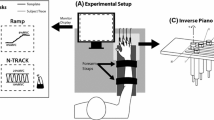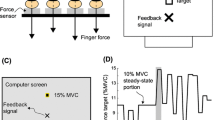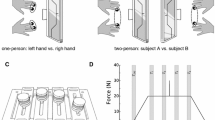Abstract
We studied changes in multi-finger synergies associated with predictable and unpredictable force perturbations applied to a finger during a multi-finger constant total force production task. The main hypothesis was that indices of multi-finger synergies can show anticipatory changes in preparation for a predictable perturbation. Subjects sat in a chair and pressed on force sensors with the four fingers of the right hand. The task was to produce a constant level of total force. The fingers acted against loads that produced upward directed forces. The loads (applied either to the index or to the ring finger) could be disengaged either by the subject or by the experimenter. An index of finger co-variation, ΔV was computed across sets of 12 trials at each time sample and for all tasks separately. During steady-state force production, all subjects showed positive ΔV values corresponding to strong negative covariation among finger forces interpreted as a force-stabilizing synergy. Prior to self-triggered unloading, subjects showed an anticipatory drop in ΔV that started 100–125 ms prior to the unloading time. Such early changes were absent in trials with experimenter-triggered unloading. After an unloading, subjects changed forces of both perturbed and unperturbed fingers and reached a new sharing pattern of the total force. In experimenter-triggered conditions, changes in the forces of unperturbed fingers could be seen as early as 120 ms following an unloading. The index ΔV dropped following a perturbation and then recovered; the recovery occurred faster in self-triggered conditions. We conclude that humans can use feed-forward changes in multi-finger synergies (anticipatory synergy adjustments) in anticipation of a predictable perturbation. These changes may help avoid prolonged weakening of a multi-digit force-stabilizing synergy. We discuss a possibility that anticipatory postural adjustments may represent a particular case of the phenomenon of anticipatory synergy adjustments and suggest a hierarchical control scheme that incorporates a possibility of independent control over the output of a multi-element system and covariation patterns among outputs of its elements.






Similar content being viewed by others
References
Aruin AS, Latash ML (1996) Anticipatory postural adjustments during self-initiated perturbations of different magnitude triggered by a standard motor action. Electroencephalogr Clin Neurophysiol 101:497–503
Aruin AS, Forrest WR, Latash ML (1998) Anticipatory postural adjustments in conditions of postural instability. Electroencephalogr Clin Neurophysiol 109:350–359
Bassin FV, Bernstein NA, Latash LP (1966) On the problem of the relation between structure and function in the brain from a contemporary point of view. In: Grastschenkov NI (ed) Physiology in clinical practice. Nauka, Moscow, pp 38–71 (an English translation is available in Motor Control 3:329–345 and 4:125–149)
Belen’kii VY, Gurfinkel VS, Pal’tsev YI (1967) Elements of control of voluntary movements. Biofizika 10:135–141
Bernstein NA (1947) On the construction of movements. Medgiz, Moscow (in Russian)
Bouisset S, Zattara M (1987) Biomechanical study of the programming of anticipatory postural adjustments associated with voluntary movement. J Biomech 20:735–742
Chan CWY, Kearney RE (1982) Is the functional stretch response servo controlled or preprogrammed? Electroencephalogr Clin Neurophysiol 53:310–324
Cordo PJ, Nashner LM (1982) Properties of postural adjustments associated with rapid arm movements. J Neurophysiol 47:1888–1905
Danion F, Schöner G, Latash ML, Li S, Scholz JP, Zatsiorsky VM (2003) A force mode hypothesis for finger interaction during multi-finger force production tasks. Biol Cybern 88:91–98
De Wolf S, Slijper H, Latash ML (1998) Anticipatory postural adjustments during self-paced and reaction-time movements. Exp Brain Res 121:7–19
Domkin D, Laczko J, Jaric S, Johansson H, Latash ML (2002) Structure of joint variability in bimanual pointing tasks. Exp Brain Res 143:11–23
Dufossé M, Hugon M, Massion J (1985) Postural forearm changes induced by predictable in time or voluntary triggered unloading in man. Brain Res 60:330–334
Feldman AG (1986) Once more on the equilibrium-point hypothesis (λ-model) for motor control. J Mot Behav 18:17–54
Freitas SMSF, Duarte M, Latash ML (2006) Two kinematic synergies in voluntary whole-body movements during standing. J Neurophysiol (in press)
Friedli WG, Cohen L, Hallett M, Stanhope S, Simon SR (1984) Postural adjustments associated with rapid voluntary arm movements. I. Electromyographic data. J Neurol Neurosurg Psychiatr 51:232–243
Hager-Ross C, Schieber MH (2000) Quantifying the independence of human finger movements: comparisons of digits, hands, and movement frequencies. J Neurosci 20:8542–8545
Hirschfeld H, Forssberg H (1991) Phase-dependent modulations of anticipatory postural activity during human locomotion. J Neurophysiol 66:12–19
Hugon M, Massion J, Wiesendanger M (1982) Anticipatory postural changes induced by active unloading and comparison with passive unloading in man. Pflugers Arch 393:292–296
Koshland GF, Gerilovsky L, Hasan Z (1991) Activity of wrist muscles elicited during imposed or voluntary movements about the elbow joint. J Mot Behav 23:91–100
Krishnamoorthy V, Latash ML (2005) Reversals of anticipatory postural adjustments during voluntary sway. J Physiol 565:675–684
Lacquaniti F, Maioli C (1989) The role of preparation in turning anticipatory and reflex responses during catching. J Neurosci 9:1134–1148
Latash ML, Scholz JF, Danion F, Schöner G (2001) Structure of motor variability in marginally redundant multi-finger force production tasks. Exp Brain Res 141:153–165
Latash ML, Scholz JP, Schöner G (2002) Motor control strategies revealed in the structure of motor variability. Exerc Sport Sci Rev 30:26–31
Latash ML, Olafsdottir H, Shim JK, Zatsiorsky VM (2005a) Synergies that stabilize and destabilize action. In: Gantchev N (ed) From basic motor control to functional recovery—IV. Marin Drinov Academic Publishing House, Sofia, Bulgaria, pp 19–25
Latash ML, Shim JK, Smilga AV, Zatsiorsky VM (2005b) A central back-coupling hypothesis on the organization of motor synergies: a physical metaphor and a neural model. Biol Cybern 92:186–191
Lee WA, Buchanan TS, Rogers MW (1987) Effects of arm acceleration and behavioral conditions on the organization of postural adjustments during arm flexion. Exp Brain Res 66:257–270
Li Z-M, Latash ML, Zatsiorsky VM (1998) Force sharing among fingers as a model of the redundancy problem. Exp Brain Res 119:276–286
Li Z-M, Zatsiorsky VM, Latash ML, Bose NK (2002) Anatomically and experimentally based neural networks modeling force coordination in static multi-finger tasks. Neurocomputing 47:259–275
Loève M (1997) Probability theory I, 4th edn. Springer, Berlin Heidelberg New York
Massion J (1992) Movement, posture and equilibrium: interaction and coordination. Prog Neurobiol 38:35–56
Müller H, Sternad D (2003) A randomization method for the calculation of covariation in multiple nonlinear relations: illustrated with the example of goal-directed movements. Biol Cybern 89:22–33
Nashner LM, Cordo PJ (1981) Relation of automatic postural responses and reaction-time voluntary movements of human leg muscles. Exp Brain Res 43:395–405
Olafsdottir H, Yoshida N, Zatsiorsky VM, Latash ML (2005) Anticipatory covariation of finger forces during self-paced and reaction time force production. Neurosci Lett 381:92–96
Ramos CF, Stark LW (1988) Modeling the neurological control of human movements. J Mot Behav 20:462–473
Saltiel P, Wyler-Duda K, D’Avella A, Tresch MC, Bizzi E (2001) Muscle synergies encoded within the spinal cord: evidence from focal intraspinal NMDA iontophoresis in the frog. J Neurophysiol 85:605–619
Scholz JP, Schoner G (1999) The uncontrolled manifold concept: identifying control variables for a functional task. Exp Brain Res 126:289–306
Scholz JP, Schöner G, Latash ML (2000) Identifying the control structure of multijoint coordination during pistol shooting. Exp Brain Res 135:382–404
Scholz JP, Danion F, Latash ML, Schöner G (2002) Understanding finger coordination through analysis of the structure of force variability. Biol Cybern 86:29–39
Scholz JP, Kang N, Patterson D, Latash ML (2003) Uncontrolled manifold analysis of single trials during multi-finger force production by persons with and without Down syndrome. Exp Brain Res 153:45–58
Shim JK, Latash ML, Zatsiorsky VM (2003) Prehension synergies: trial-to-trial variability and hierarchical organization of stable performance. Exp Brain Res 152:173–184
Shim JK, Lay B, Zatsiorsky VM, Latash ML (2004) Age-related changes in finger coordination in static prehension tasks. J Appl Physiol 97:213–224
Shim JK, Latash ML, Zatsiorsky VM (2005a) Prehension synergies in three dimensions. J Neurophysiol 93:766–776
Shim JK, Olafsdottir H, Zatsiorsky VM, Latash ML (2005b) The emergence and disappearance of multi-digit synergies during force production tasks. Exp Brain Res 164:260–270
Shiratori T, Latash ML (2001) Anticipatory postural adjustments during load catching by standing subjects. Clin Neurophysiol 112:1250–1265
Tatton WG, Bawa P, Bruce IC, Lee RG (1978) Long loop reflexes in monkeys: an interpretive base for human reflexes. Prog Clin Neurophysiol 4:229–245
Winter DA, Prince F, Frank JS, Powell C, Zabjek KF (1996) Unified theory regarding A/P and M/L balance in quiet stance. J Neurophysiol 75:2334–2343
Woollacott MH, Manchester DL (1993) Anticipatory postural adjustments in older adults: are changes in response characteristics due to changes in strategy? J Gerontol 48:M64–M70
Zatsiorsky VM, Latash ML (2004) Prehension synergies. Exerc Sport Sci Rev 32:75–80
Zatsiorsky VM, Li Z-M, Latash ML (1998) Coordinated force production in multi-finger tasks. Finger interaction and neural network modeling. Biol Cybern 79:139–150
Acknowledgments
The study was in part supported by NIH grants NS-35032, AG-018751, AR-048563, and M01 RR-10732.
Author information
Authors and Affiliations
Corresponding author
Rights and permissions
About this article
Cite this article
Kim, S.W., Shim, J.K., Zatsiorsky, V.M. et al. Anticipatory adjustments of multi-finger synergies in preparation for self-triggered perturbations. Exp Brain Res 174, 604–612 (2006). https://doi.org/10.1007/s00221-006-0505-8
Received:
Accepted:
Published:
Issue Date:
DOI: https://doi.org/10.1007/s00221-006-0505-8




